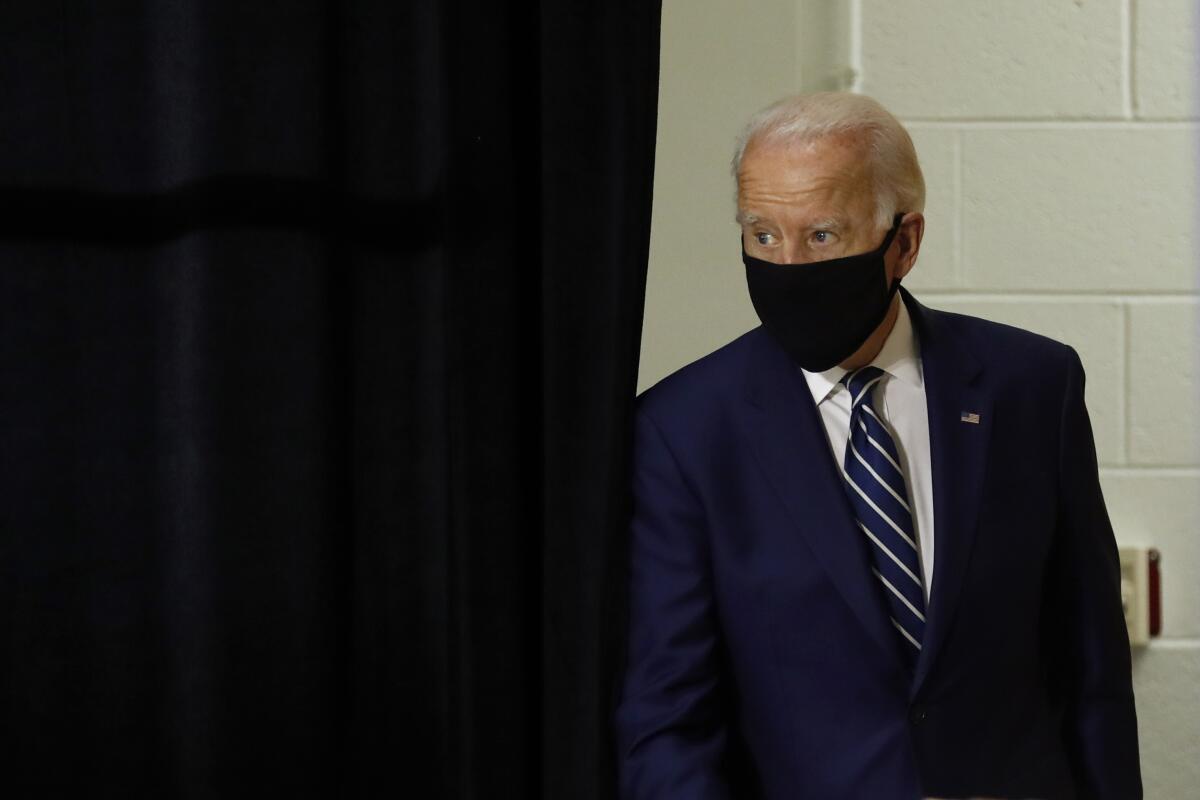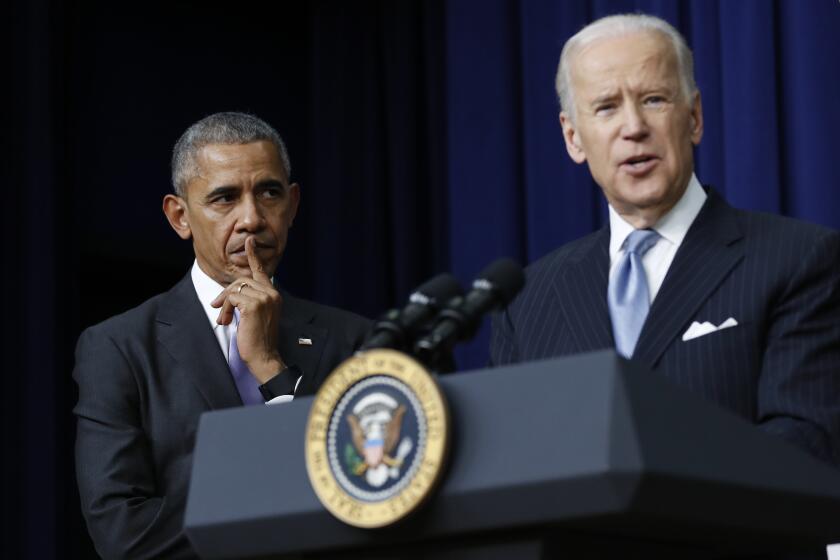Biden leads in the polls: Could they be missing something?

- Share via
WASHINGTON — The team behind the Economist’s 2020 election forecast designed their model to consider lots of factors: polls, economic conditions, presidential approval ratings, political polarization, the presence of an incumbent.
What didn’t get factored in?
“We don’t try to model the probability of a meteor strike,” said Andrew Gelman, a professor of statistics and political science at Columbia University who helped design the model.
Of course, the likelihood of a meteor strike radically disrupting the electoral landscape between now and November is pretty slim. But then again, not too long ago, few would have guessed that the campaign would be crescendoing amid a global pandemic.
Former Vice President Joe Biden has a big lead over President Trump in polls nationally and in key swing states. But with memories of Trump’s upset victory in 2016 still fresh, professional pollsters as well as average voters are spending a lot of time wondering whether something unexpected might trip up forecasts again this year. Many of the uncertainties involve the impact of the worldwide health crisis.
Four years ago, a mix of methodological mistakes and political circumstance led many analysts to confidently predict a Hillary Clinton presidency, only for Trump to win instead.
The former president and his onetime sidekick, and now would-be heir, get together at a distance to trash Trump and promote Biden’s candidacy.
That error came after an election cycle that seemed unique at the time: a political outsider and former reality show host on one hand, the first female nominee of a major political party on the other. This time around, circumstances feel equally novel, albeit for very different reasons.
But Gelman notes that his model, which currently gives Biden a better than 9-in-10 probability of winning, is less concerned with what’s special about the current moment than with “the general range of specialness that can occur,” as captured by the historical data.
“People have said, ‘Well, 2020 is special,’” he explained. “But you go back every election: 1948 was the first election without Franklin Roosevelt running in a really long time, right? 1952 had Dwight Eisenhower, who was a uniquely non-partisan figure. 1960 had [John F.] Kennedy, who was the first Catholic .... You can keep going; just about every election, there’s been something special and unusual.”
The pandemic, then, might be unusual — but historically speaking, being unusual is the usual.
Even if forecasters did want their models to explicitly account for the coronavirus, there doesn’t seem to be an empirical way to incorporate whatever extra error the pandemic introduces, said G. Elliott Morris, the Economist data journalist with whom Gelman worked.
“You [would] have to make assumptions about how much error you’re going to add,” Morris said. “Those assumptions are really hard to make in a way that makes your model better.”
But with months to go until election day, there’s plenty of time for things to change.
Courtney Kennedy, director of survey research at Pew Research Center, said she doesn’t know what impact the coronavirus will have on the ability of polls to forecast the outcome of the election, but it’s reasonable to expect some sort of effect.
“I think it’s one of the big reasons why folks really can’t take [a poll], especially a national poll, in June or July right now, and assume that that translates into votes,” she said.
Trump and his aides have long ignored ethics norms, and the president is escalating his use of official events to attack Joe Biden and Democrats.
Beyond whatever uncertainty the pandemic adds, polls still have the hard job of estimating who is really going to vote. In hindsight, experts think a lot of the problems in 2016 involved state polls overrepresenting college graduates, who were disproportionately pro-Clinton.
Charles Franklin, director of the Marquette Law School Poll in Wisconsin, said that the “vast majority” of pollsters now weight their results to make sure the share of college-educated voters in their polling sample matches the share in the population. But, said Kennedy, not all do.
This time around, Morris said, problems with polling accuracy could arise if the virus produces a systematic gap between the people whom pollsters believe to be likely voters and those who actually turn out.
If a difference were to affect one party significantly more than the other — if Biden supporters disproportionately failed to vote because they were more worried about the virus, for example — polls that failed to take that into account would give inaccurate results.
Morris is skeptical that will happen.
“I think you kind of start to get into conspiracy-theory land if you’re going to say that the coronavirus is going to kill 30 million more Democrats than Republicans, or make them more afraid to vote,” he explained.
Nathaniel Rakich, an elections analyst for prominent forecasting outlet FiveThirtyEight.com noted the virus could disrupt the electoral process in other ways.
“You’ve seen it in primaries: There have been voters who haven’t been able to vote because of problems with absentee ballots, there have been long lines at some primaries,” he said.
The economic impact of the pandemic could also complicate polling, Franklin said. One problem would be if large numbers of people “lose their homes and have to move, because that can involve re-registering to vote,” which isn’t always easy, he said.
Ironically, the pandemic has also yielded benefits for polls. Marquette is seeing more people agree to participate in polls, Franklin said, attributing that to more people being at home when the phone rings. There’s also indication that more men are responding than usual.
And as pandemic conditions make mail-in ballots increasingly common, polls might enjoy a bump in accuracy. When the election nears, the fact that a higher-than-usual number of people already will have voted could reduce the risk that late-deciding voters swing the outcome.
In 2016, late-deciding voters disproportionately broke to the right in key states.
This time around, when “Trump is now a known commodity,” Kennedy said, there’s good reason to question whether another such a buzzer-beater pivot would occur. But early voters could turn out to be consistently different from election-day voters.
“I don’t think we have good empirical tests about how much [early voting] matters, because we’ve never been in a situation like this, with such a big increase,” Franklin said. Pollsters will be watching “to see whether those who’ve already voted are in any ways different from those who have yet to make up their minds, or yet to vote in-person.”
A final question that hovers over survey research is whether the errors of 2016 augured a permanent shift toward less accurate polling. In general, however, pollsters remain cautiously optimistic.
In the 2018 midterms, polling proved highly accurate, Kennedy noted. “My big takeaway from 2018 was that it demonstrated … that fundamentally, polling is not broken,” she said. Despite how things may have felt after 2016, “polls that are done carefully can still perform well.”
More to Read
Get the L.A. Times Politics newsletter
Deeply reported insights into legislation, politics and policy from Sacramento, Washington and beyond. In your inbox three times per week.
You may occasionally receive promotional content from the Los Angeles Times.













